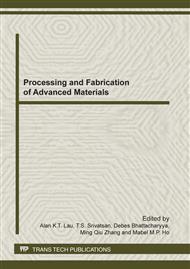p.329
p.333
p.337
p.341
p.345
p.349
p.353
p.357
p.361
Molding of C-FRP Plate with Using Induction Heating
Abstract:
Recently, the market for composite materials is dominated by small and medium series production and prototyping [1]. And the VaRTM (Vacuum assisted Resin Transfer Moldings) process is thought to be low cost composite fabrication technique [2]. The preforms in VaRTM are placed on one–side mold and they are sealed by a flexible vacuum bag [3]. The resin is infused into dry fabric formed on a mold near product shape under vacuum pressure and cured in an oven. In general, part defects often arise during the mold filling stage of the process, where a resin is drawn into performs through the use of vacuum. Uniform fill of resin and complete fiber saturation are required for fabricating high quality products [5]. So the resin flow control is extremely required. To solve these problems and short time fabrication, this article investigates the new molding process of C-FRP plate with using the combination of induction heating for quick heating and vacuuming method. To control of the volume fraction easily and to achieve homogeneous impregnation, thermoplastic resin sheet was chosen instead of liquid type. And the C-FRP in a size of 120mm*120mm and the thickness is 6.6mm was able to fabricate by this method.
Info:
Periodical:
Pages:
345-348
Citation:
Online since:
November 2011
Authors:
Keywords:
Price:
Сopyright:
© 2012 Trans Tech Publications Ltd. All Rights Reserved
Share:
Citation:


